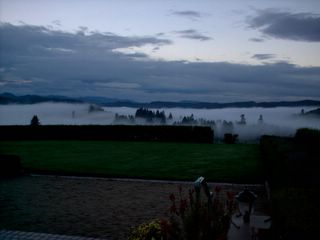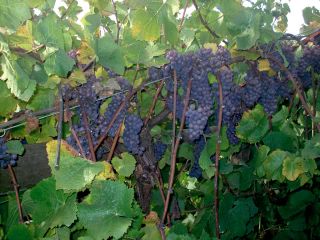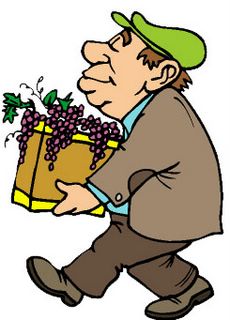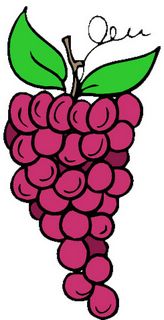Pinot Gris is a white wine grape grown in cool climate regions all over the world. Pinot Gris is called Pinot Grigio in Italy, and the grape is grown in many regions, although, arguably, most successfully in Alsace (France), Italy, Germany, and Oregon. Pinot Gris produces wines that are generally fruity in aroma, with flavors of honey, apple, pear, vanilla, oak, and citrus.
Friday, December 16, 2005
Don't Like Wine? Try Ice Wine
I'll bet most of those critics have never tried Ice Wine. Recently, I have given a few bottles away, and without exception, everyone has made it a point to tell me how much they loved the wine. The dessert wines usually come in 375 ml (half-size) bottles. Pinot Gris grapes are often used in the production of Ice Wine, along with Muscat and Gewurztraminer.
If you've never tried Ice Wine, look for it the next time you're in your local supermarket. if they don't carry it there, try a wine shop or a World Market.
Wednesday, November 23, 2005
What Wine Goes With Turkey?
There are, of course, many wine selections that will go with turkey and traditional holiday meals.
If your guests prefer white wines, then Pinot Gris would be the natural choice for a match with turkey. There are many good ones, and you should be able to find a bottle or two at your supermarket in the $10 - $15 range. Another white wine that would win your guests over is a bottle of Viognier, which might be a little harder to find than the Pinot Gris, but is a crisp alternative to the ever-boring Chardonnay.
If you usually like wine with a little sweetness, try a White Zinfandel. If you think you'd like to try a dessert wine, you might look for a sparkling Early Muscat or a bottle of Vin Glace made with Pinot Gris grapes. The Vin Glace will usually come in the 375 ml bottle.
If your guests prefer red wines, consider a Pinot Noir to go with your turkey. It will have a richer fruit flavor than most white wines, but will match up well with the meal. Pinot Noir is traditionally very smooth, so it will not overwhelm the taste of the food.
Look for a bottle from Oregon, California, or France in the $15 - $20 range. Serve Pinot Noir very lightly chilled (about 60 degrees Fahrenheit). Put the Pinot Noir in the refrigerator for about 20 minutes before serving, and you will bring out the fruit flavors and will remove the alcohol taste that can overwhelm when served at room temperature.
I would avoid any bold reds, unless the meal features some form of red meat. That means leave the Cabernet Sauvignon in the cellar for a more opportune time.
Wednesday, November 16, 2005
Oregon Pinot Gris is Washington Times Wine of the Week
"Pinot gris is something of a chameleon. Pick the grapes early in the harvest and the wine most likely will taste steely. Pick them late, and it will seem almost honeyed. But pick somewhere in the middle, and the wine will be redolent of crisp apples and pears and just right for serving at Thanksgiving."
Read the rest of the article here.
Wednesday, November 02, 2005
What In the World is Pinot Gris?
Pinot Grigio (Italy)
Pinot Beurot (Loire Valley, France)
Ruländer (Austria and Germany, Romania, sweet)
Grauburgunder or Grauer burgunder (Austria and Germany, dry)
Grauklevner (Germany)
Malvoisie (Loire Valley, France and Switzerland)
Tokay d'Alsace (Alsace) (currently being renamed due to EU regulations)
Auxerrois Gris (Alsace)
Fromentau (Langudoc, France)
Fromentot (France)
Fauvet (France)
Gris Cordelier (France)
Grauer Mönch (Germany)
Monemrasia
Crvena Klevanjka (Croatia)
Sivi Pinot (Slovenia)
Szürkebarát (Hungary)
"Pinot" means "pinecone" in French, and "gris" means gray. The grapes grow in small clusters (hence the pinecone shape), and upon ripening, often display a pinkish-gray hue, although the colors can vary from blue-gray to pinkish-brown.
Pinot Gris is called Pinot Grigio in Italy, and the grape is grown in many regions, although, arguably, most successfully in Alsace (France), Italy, Germany, and Oregon. In the United States, Pinot Gris has recently supplanted Sauvignon Blanc as the most popular white wine grape next to Chardonnay.
Pinot Gris produces wines that are generally fruity in aroma, with flavors of honey, apple, pear, vanilla, oak, and citrus. The flavors can vary from region to region, but a good Pinot Gris will display crisp acidity, balanced with silky sweetness, resulting in a complex array of flavors on the pallet. Pinot gris goes well with foods typically associated with white wines, including fish, seafood, chicken, pork, and Asian cuisine.
Pinot Gris is thought to have originated in the Burgundy region of France, and was planted in Northern Europe for many years before making its way to Oregon in the 1960's. The grape is presently grown in many different areas, but prefers the relatively cool climate of places like France, Germany, Italy and Oregon, where the long (but not too hot) summer days mingled with cool autumn weather bring the grapes into perfect ripeness.
Pinot Gris grapes grown in Italy (Pinot Grigio) usually produce a somewhat wanting, light-colored wine with crisp acidity. German Pinot Gris tends to be medium-bodied, with good balance between sugar and acidity. Grapes grown in Oregon tend to produce a wine that is medium-bodied, exhibiting strong fruit flavors and aromas and superb crispness. Pinot Gris produced from grapes grown in the Alsace region of France has proven to show full-bodied, floral flavors, and a deep viscosity with a long-lasting finish.
Pinot Gris made from grapes grown in other regions can also be delicious, but generally don't deliver the same excellent qualities that people have come to expect from wines made in the regions listed above. California is one area where Pinot Gris is grown, but the wines made there tend to be flabby, losing their complexity due to the warmer weather. In fact, Pinot Gris produced in California is often called Pinot Grigio because of the similarity in style to the wines from Italy.
Technorati: Wine
Friday, October 28, 2005
What is Ice Wine?
Pinot Gris grapes can make an outstanding Ice Wine, sometimes called Vin Glace. The wine is usually sold in 375 ml bottles, and should be available at many fine wine outlets.
Wine
Tuesday, October 25, 2005
Harvest Has Ended
Monday, October 17, 2005
Thursday, October 13, 2005
Whole Lotta Gris
Oregon Pinot Gris
What's So Great About Pinot Gris?
Tuesday, October 11, 2005
Grapes in the Sun
Pinot Gris Against a Blue Sky

Blue Grape Sky

The optimal grape-growing season is featured with frost-less spring, a long, warm, growing season, and good weather at harvest time. The long summer days provide the heat units that the grapes crave. Depending on the area, Pinot Gris grapes need anywhere from 1900 to 2500 Degree Days to mature. A Degree Day is the average temperature minus fifty degrees Fahrenheit. So a day with an average temperature of 71 degrees would have 21 Degree Days.
Monday, October 10, 2005
Pinot Gris on the Vine

Pinot Gris Clusters

Pinot Gris is usually a mid-harvest grape, while its counterpart, Pinot Noir, is an early-harvest grape. The picture above was taken about a week before harvest. Note how the grapes hang on the lower half of the vine, maximizing morning sun exposure, when the grapes are most vulnerable to excess moisture. This also makes picking the grapes very quick and easy.
Gris Means 'Grey'

Pinot Gris Closeup

Here's a closeup shot of some Pinot Gris clusters about a week before the harvest. Note the yellow color of some of the leaves, indicating the onset of autumn. There are no green grapes at this point. The grapes are all purple-brown, or purple-grey. Smaller grapes have better flavor concentration than large ones. Most vineyard managers strive for uniformity when it comes to grape size.
Pinot Gris on the Web
Saturday, October 08, 2005
Wine Coupons
Here are some coupon codes to use when you shop there:
15% off
CODE:PLATINUM
25% off 12 Bottles is combination of the automatic 10% off 12+ bottles and 15% off CODE:PLATINUM
10% off codes SIGNUP10 and USAEVM may also work
CODE:THANKYOU
Thursday, October 06, 2005
Wine Quotes
"Beer is made by men, wine by God!" - Martin Luther
"And Noah began to be a husbandman, and he planted a vineyard." - Genesis 9:20
"I have enjoyed great health at a great age because everyday since I can remember, I have consumed a bottle of wine except when I have not felt well. Then I have consumed two bottles." - Bishop of Seville
“Wine makes a man more pleased with himself; I do not say it makes him more pleasing to others.” - Samuel Johnson
Wednesday, October 05, 2005
Overlooking the Vineyard

Misty Morning

Vineyards are usually planted on gently sloping hills. This helps eliminate "frost pockets", which can prove deadly to buds in springtime. Some moisture is good for grapes, but too much humidity will leave the grapes mushy or moldy. Cool morning temperatures around harvest time can add crispness to the grapes' flavor.
Life In The Vineyard
2005 Oregon State Fair Medal Results
Best of Classification – Specialty Wines
King Estate
2004 Vin Glacé Pinot Gris
Eugene, Oregon
Gold Medals:
Bridgeview Vineyards
2003 Pinot Gris, Blue Moon, Oregon
Firesteed Cellars
2003 Pinot Gris, Oregon
King Estate Winery
2003 Pinot Gris, Oregon
2004 Vin Glace, Pinot Gris, Oregon
Willamette Valley Vineyards
2004 Pinot Gris, Willamette Valley
Silver Medals:
Ankeny Winery
2004 Pinot Gris, Willamette Valley
Cooper Mountain Vineyards
2004 Pinot Gris, Cooper Hill, Willamette Valley
ElvenGlade Vineyard
2004 Pinot Gris, Yamhill
Iris Hill Winery
2004 Pinot Gris, Oregon
Montinore Estate
2004 Pinot Gris, Willamette Valley
Paradis Vineyard
2003 Pinot Gris, Estate, Willamette Valley
Pheasant Valley Vineyard and Winery
2004 Pinot Gris, Columbia Gorge
Bronze Medals:
Airlie Winery
2003 Pinot Gris, Willamette Valley
Eola Hills Wine Cellars
2004 Pinot Gris, Oregon
Hauer of the Dauen
2002 Pinot Gris, Willamette Valley
Sahalie Wine Cellars
2004 Pinot Gris, Willamette Valley
Stone Wolf Vineyards
2004 Pinot Gris, Oregon
Wine By Joe
2004 Pinot Gris, Willamette Valley
Monday, September 26, 2005
A Pinot Gris by any other name...
Pinot Gris (or Tokay Pinot Gris) is a white wine grape of species Vitis Vinifera related to Pinot Noir which goes by a lot of other names:
Pinot Grigio (Italy)
Pinot Beurot (Loire Valley, France)
Ruländer (Austria and Germany, Romania, sweet)
Grauburgunder or Grauer burgunder (Austria and Germany, dry)
Grauklevner (Germany)
Malvoisie (Loire Valley, France and Switzerland)
Tokay d'Alsace (Alsace) (currently being renamed due to EU regulations)
Auxerrois Gris (Alsace)
Fromentau (Langudoc, France)
Fromentot (France)
Fauvet (France)
Gris Cordelier (France)
Grauer Mönch (Germany)
Monemrasia
Crvena Klevanjka (Croatia)
Sivi Pinot (Slovenia)
Szürkebarát (Hungary)
...from wikipedia, the free web encyclopedia.
Saturday, September 24, 2005
What in the World is Pinot Gris?
Pinot Gris is called Pinot Grigio in Italy, and the grape is grown in many regions, although, arguably, most successfully in Alsace (France), Italy, Germany, and Oregon. In the United States, Pinot Gris has recently supplanted Sauvignon Blanc as the most popular white wine grape next to Chardonnay.
Pinot Gris produces wines that are generally fruity in aroma, with flavors of honey, apple, pear, vanilla, oak, and citrus. The flavors can vary from region to region, but a good Pinot Gris will display crisp acidity, balanced with silky sweetness, resulting in a complex array of flavors on the pallet. Pinot gris goes well with foods typically associated with white wines, including fish, seafood, chicken, pork, and Asian cuisine.
wine
Friday, September 23, 2005
Where in the world is the Pinot Gris grape grown?
Pinot Gris grapes grown in Italy (Pinot Grigio) usually produce a somewhat wanting, light-colored wine with crisp acidity. German Pinot Gris tends to be medium-bodied, with good balance between sugar and acidity. Grapes grown in Oregon tend to produce a wine that is medium-bodied, exhibiting strong fruit flavors and aromas and superb crispness. Pinot Gris produced from grapes grown in the Alsace region of France has proven to show full-bodied, floral flavors, and a deep viscosity with a long-lasting finish.
Pinot Gris made from grapes grown in other regions can also be delicious, but generally don't deliver the same excellent qualities that people have come to expect from wines made in the regions listed above. California is one area where Pinot Gris is grown, but the wines made there tend to be flabby, losing their complexity due to the warmer weather. In fact, Pinot Gris produced in California is often called Pinot Grigio because of the similarity in style to the wines from Italy.
Where in the world can I find some Pinot Gris?
Restaurants - Easily the most expensive place to buy wine, the restaurant offers a cozy atmosphere, sometimes knowledgeable waiters, and comprehensive wine list. For a decent bottle of Pinot Gris, be prepared to pay 30 to 40 dollars or more, depending on how fancy the establishment is. One idea for frugal restaurant dining is to call beforehand and ask if you can bring in your own delicious bottle of Pinot Gris. The restaurant will charge you a nominal "pouring fee", but you won't have to shell out the big bucks.
Supermarkets - Probably the least expensive place to purchase wine, your neighborhood Safeway or Albertsons offers a variety of Pinot Gris at prices ranging from $7 to $20. Just don't expect too much help from the stockboy when deciding which Pinot Gris would go best with osso buco.
Tasting Rooms - Many wineries have their own tasting rooms with dramatic views and enchanting music geared to put the consumer into a wine buying-trance. If you buy Pinot Gris from the tasting room, however, you are usually buying directly from the winery, and won't get the big discounts that the stores receive. Expect to pay somewhere between 15 to 30 dollars for a good bottle of Pinot Gris.
The Internet - A great place to shop for wine in general, the web offers you some super deals. The upside of web shopping is that you can browse the wine shoppe at 3 AM if you desire. The downside is that every state has their own particular wine laws, and you may have to shop for awhile before you can find someone to ship Pinot Gris to your state. Oh, and you have to pay the shipping costs, and the wine may be exposed to all kinds of elements and hazards on its way to your door.
Wine Festivals - If you live in a reasonably populated area, chances are that you have an annual wine festival within 20 miles or so. These are great places to try a variety of wines by the glass, and mingle amongst large crowds. You will probably be paying close to Tasting Room prices, though, so a bottle of Pinot Gris will run you 12 to 25 dollars.
Wine Shops - Most wine shops have prices that are competitive with those found in the supermarkets. Wine shops also carry a nice variety of wines, but best of all, the owners or workers will often possess valuable knowledge that they will share with you most whole-heartedly if you promise to buy a bottle or two.
What food goes well with Pinot Gris?
Here are some great recipes for that bottle of Pinot Gris that you've been saving...
Baked Fish
Ingredients : 2 lbs. of fish, 2 tablespoons of butter, 2 level tablespoons of flour, 2 onions, 2 cloves of garlic, Salt and pepper to taste, 1 cup of milk, 1 sprig of thyme, 1 sprig of chive, 4 dashes of Angostura aromatic bitters.
Instructions : Clean and wash fish with lime or lemon. Season with tomatoes, onions, garlic, chive, thyme, salt and pepper. Put into a greased baking dish. Lay seasonings on top of fish. Make a smooth paste of the milk and flour and pour over the fish. Add butter and Angostura aromatic bitters and bake for 30 minutes in a moderate oven. Serve with boiled or fried potatoes.
Chicken Parmesan
Ingredients : 4 half chicken breasts - skinned and boned, 2 cans (14½ oz. each) Italian style stewed tomatoes, 2 tablespoons of cornstarch, ½ teaspoon of oregano or basil - crushed, ¼ teaspoon of hot pepper sauce (optional), ¼ cup of grated Parmesan cheese.
Instructions : Place chicken in baking dish. Baked covered 15 minutes in preheated oven - at 425º F. Drain. Combine tomatoes, cornstarch, oregano and pepper sauce. Cook, stirring constantly, until sauce is thickened. Pour heated sauce over chicken and top with cheese. Bake 5 minutes, uncovered. Serve garnished with parsley.
Linguini with Scallop & Basil Sauce
Ingredients : ¼ lb. of linguini pasta - preferably home made, ¼ lb. of scallops (use half and substitute fish cut in same shape for the other serving), 1 tablespoon each of butter and olive oil, 1 garlic clove - minced, ¼ teaspoon dried crush red pepper flakes, 2 tablespoons of chopped fresh parsley, 4 tablespoons of chopped fresh basil, ½ cup of cream, Salt and pepper to taste.
Instructions : Cook linguini according to package directions. While linguini cooks, heat both butter and oil in a small frying pan, add garlic and cook till just beginning to turn golden (do not allow it to brown). Add pepper flakes, parsley and basil, and cook for a few seconds. Add ½ cup of cream, the scallops, salt and pepper to taste and simmer 4 to 5 minutes or till scallops are cooked. Drain linguini, toss with sauce and serve. Grated parmesan cheese may be served over the dish if desired.
Osso Buco
Ingredients : 10 meaty veal shanks - 2 to 3 inches thick, Salt and pepper, 1/2 to 2/3 cup all-purpose flour, 6 tablespoons butter - divided, 4 tablespoons extra virgin olive oil, 4 turns of the pan, 1 large onion - chopped, 2 large carrots - peeled and cut into a fine dice, 4 ribs celery -chopped, 6 to 8 cloves garlic - crushed, 3 sprigs fresh rosemary - stripped and finely chopped, about 2 tablespoons, 1/2 teaspoon allspice, 2 cups white wine, 1 (28-ounce) can chunky style crushed tomatoes, 2 cups chicken stock, 2 (14-ounce) cans cannelloni beans - drained, 1 lemon -rind cut into pieces, Gremolata:2 lemons, zested, 4 cloves garlic, crushed, 6 anchovy fillets in oil, drained, 1 cup flat leaf parsley leaves, 3 handfuls.
Instructions : Preheat oven to 375 degrees F. Place a large, heavy bottomed skillet on the stove and heat pan over moderate to high flame. Salt and pepper the shanks and coat lightly and evenly in flour. Working in 2 batches, brown shanks in 1 1/2 tablespoons each butter and olive oil. Transfer shanks to a large roasting pan. Add remaining butter and oil to the pan and saute the root vegetables and crushed garlic 5 minutes, seasoning them with rosemary, allspice, salt and pepper. Add wine to the pan and reduce 2 to 3 minutes, lifting pan drippings up off the bottom of your pot. Add tomatoes, chicken stock and white beans to the pan and remove from heat. Stir to combine sauce. Pour sauce and vegetables evenly over shanks. Cover roasting pan tightly and roast for 1 1/2 to 2 hours, until meat is very tender and pulling easily from bone. Baste meat in juices and sauce every 1/2 hour. In the last 1/2 hour, add lemon rinds to sauce.Combine lemon zest, garlic, anchovies and parsley in a large pile. Mill the mixture with your knife into a finely chopped condiment.To serve, place shank in a rimmed plate and spoon juices, beans and vegetable bits over and around meat. Top with a generous sprinkle of gremolata. Serve with Sauteed dark greens and crusty bread and/or garlic lemon potatoes.








